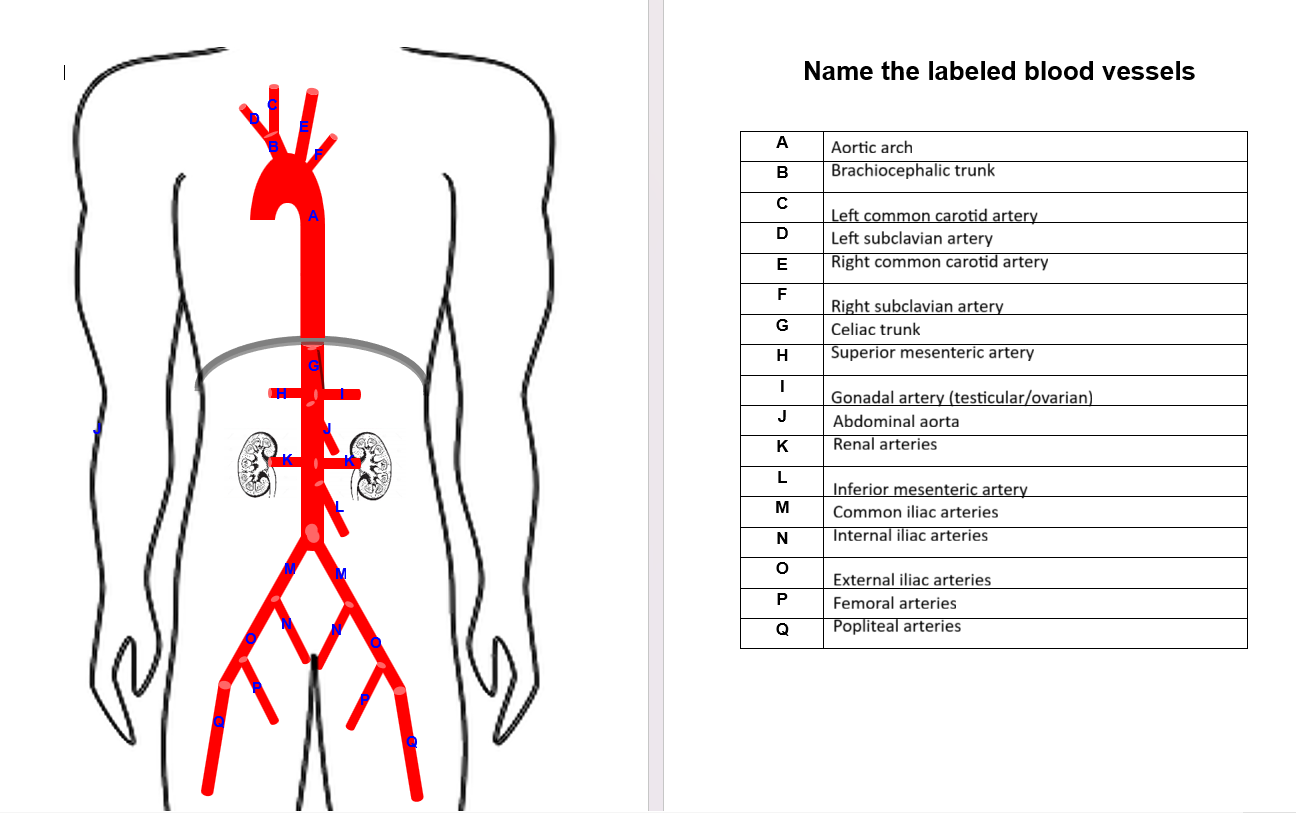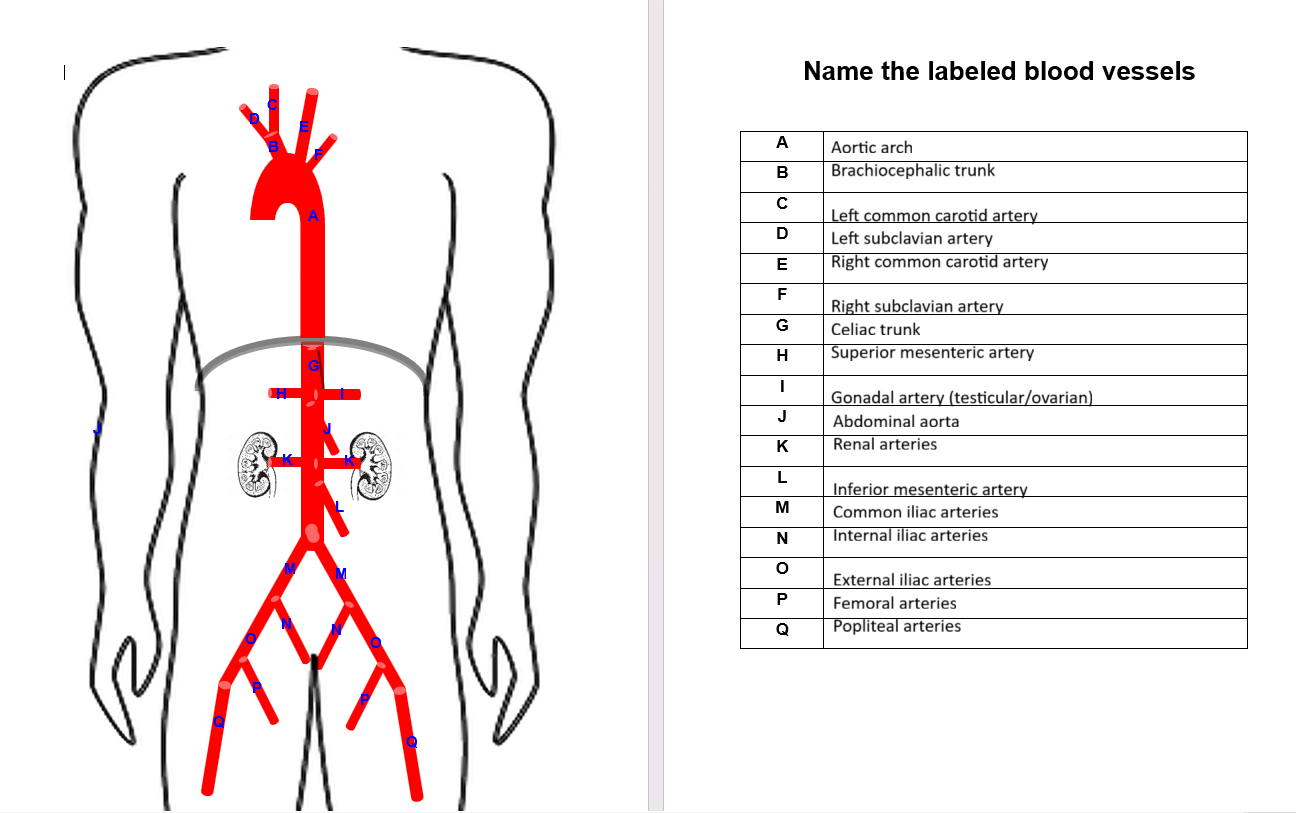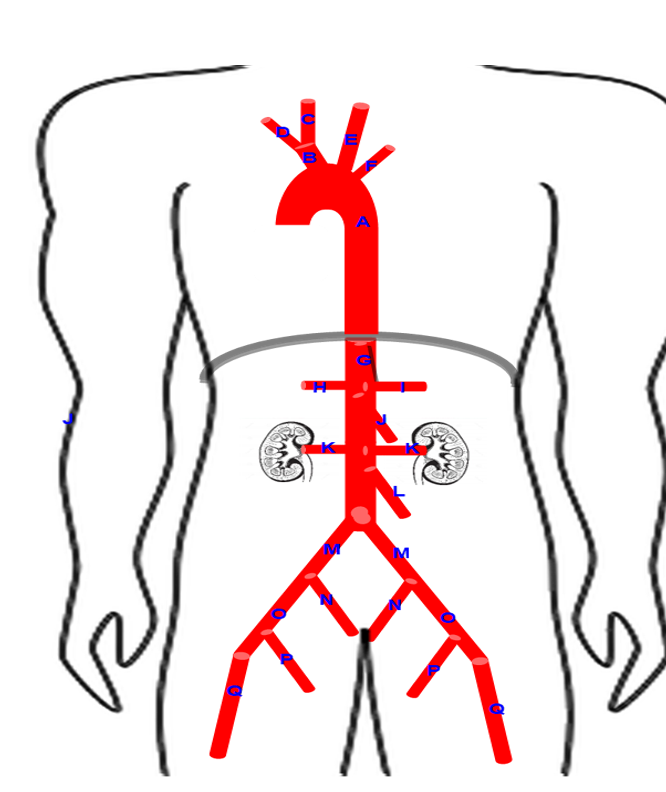Blood Vessel 1-3 Lab Worksheets Bio 221
1/29
There's no tags or description
Looks like no tags are added yet.
Name | Mastery | Learn | Test | Matching | Spaced |
|---|
No study sessions yet.
30 Terms
Where does the aorta change from the thoracic aorta to the abdominal aorta?
The thoracic aorta becomes the abdominal aorta when it passes through the aortic hiatus of the diaphragm.
How many subclavian veins are there?
There are two subclavian veins.
How many subclavian arteries are there?
There are two subclavian arteries.
What is the first branch off of the aorta in the abdominal cavity?
The first branch off of the aorta in the abdominal cavity is the celiac trunk.
When the aorta bifurcates, it branches into the _.
When the aorta bifurcates, it branches into the common iliac arteries.
Name 4 arteries who are named after the bone next to which they lie.
Four arteries named after an adjacent bone are: radial artery (radius), ulnar artery (ulna), femoral artery (femur), and tibial artery (tibia).
Which vein is most commonly used for blood drawing?
The vein most commonly used for blood drawing is the median cubital vein.
What artery is used to detect pulses in the Neck?
Carotid artery
What artery is used to detect pulses in the Wrist?
Radial artery
What artery is used to detect pulses Behind the knee?
Popliteal artery
What artery is used to detect pulses in the Groin?
Femoral artery
Which artery would be found in the armpit?
The artery found in the armpit is the axillary artery.
Describe the difference in wall thickness between arteries and veins.
Arteries have a thicker wall, especially the tunica media. Tunica adventitia is the outer connective tissue layer. Tunica media is the middle muscular layer, which is much thicker in arteries.
Identify the vessels in the umbilical cord and their function during fetal circulation.
There are 2 umbilical arteries, which carry deoxygenated blood from the fetus to the placenta. There is 1 umbilical vein, which carries oxygenated blood from the placenta to the fetus.
Which arteries fuse to form the basilar artery, a part of the Circle of Willis?
The Right vertebral artery and the Left vertebral artery.
Explain why puncturing an artery is more dangerous than puncturing a vein.
Arteries have higher pressure, resulting in rapid, pulsatile bleeding that is harder to stop. Veins have lower pressure, making bleeding easier to control.
Which vein is most commonly used for blood drawing?
The Median cubital vein (located in the antecubital fossa, between the cephalic and basilic veins).
List the arteries commonly used to detect pulses and their locations.
Neck
Carotid artery
Wrist
Radial artery
Behind the knee
Popliteal artery
Groin
Femoral artery
What artery is located in the armpit?
The Axillary artery.
Where does the thoracic aorta become the abdominal aorta?
At the diaphragm.
Identify the subclavian vessels.
2 subclavian veins (right & left) and 2 subclavian arteries (right & left).
What is the first abdominal branch of the aorta?
The Celiac trunk (celiac artery).
Into what arteries does the aorta bifurcate (split/divides)?
Into the right and left common iliac arteries.
Name four arteries that are named after nearby bones.
Femoral artery (femur)
Tibial arteries (tibia)
Radial artery (radius)
Ulnar artery (ulna)

Study
Study


Name the blood vessels
A – Aortic arch
B – Brachiocephalic trunk
C – Left common carotid artery
D – Left subclavian artery
E – Right common carotid artery
F – Right subclavian artery
G – Celiac trunk
H – Left gastric artery (branch of celiac)
I – Splenic artery (branch of celiac)
J – Superior mesenteric artery
K – Renal arteries (R & L)
L – Gonadal arteries (testicular/ovarian)
M – Abdominal aorta (before bifurcation)
N – Common iliac arteries (R & L)
O – External iliac arteries (R & L)
P – Internal iliac arteries (R & L)
Q – Femoral arteries (R & L) (Not popliteal since its not as long)